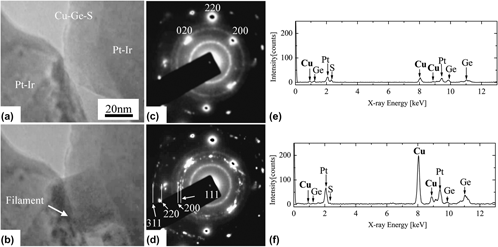Crossref Citations
This article has been cited by the following publications. This list is generated based on data provided by
Crossref.
Fujii, Takashi
Arita, Masashi
Hamada, Kouichi
Takahashi, Yasuo
and
Sakaguchi, Norihito
2013.
In-situ transmission electron microscopy of conductive filaments in NiO resistance random access memory and its analysis.
Journal of Applied Physics,
Vol. 113,
Issue. 8,
Kudo, Masaki
Arita, Masashi
Ohno, Yuuki
Fujii, Takashi
Hamada, Kouichi
and
Takahashi, Yasuo
2013.
Preparation of resistance random access memory samples for in situ transmission electron microscopy experiments.
Thin Solid Films,
Vol. 533,
Issue. ,
p.
48.
Kudo, Masaki
Arita, Masashi
Ohno, Yuuki
and
Takahashi, Yasuo
2014.
Filament formation and erasure in molybdenum oxide during resistive switching cycles.
Applied Physics Letters,
Vol. 105,
Issue. 17,
Takahashi, Yasuo
and
Arita, Masashi
2014.
In-situ TEM observation of ReRAM switching.
p.
1.
Arita, Masashi
Takahashi, Akihito
Ohno, Yuuki
Nakane, Akitoshi
Tsurumaki-Fukuchi, Atsushi
and
Takahashi, Yasuo
2015.
Switching operation and degradation of resistive random access memory composed of tungsten oxide and copper investigated using in-situ TEM.
Scientific Reports,
Vol. 5,
Issue. 1,
Arita, Masashi
Ohno, Yuuki
Murakami, Yosuke
Takamizawa, Keisuke
Tsurumaki-Fukuchi, Atsushi
and
Takahashi, Yasuo
2016.
Microstructural transitions in resistive random access memory composed of molybdenum oxide with copper during switching cycles.
Nanoscale,
Vol. 8,
Issue. 31,
p.
14754.
Arita, Masashi
Ohno, Yuuki
and
Takahashi, Yasuo
2016.
Switching of Cu/MoOx/TiN CBRAM at MoOx/TiN interface.
physica status solidi (a),
Vol. 213,
Issue. 2,
p.
306.
Arita, Masashi
and
Takahashi, Yasuo
2017.
3rd International Multidisciplinary Microscopy and Microanalysis Congress (InterM).
Vol. 186,
Issue. ,
p.
205.
Yang, Yuchao
Takahashi, Yasuo
Tsurumaki-Fukuchi, Atsushi
Arita, Masashi
Moors, M.
Buckwell, M.
Mehonic, A.
and
Kenyon, A. J.
2017.
Probing electrochemistry at the nanoscale: in situ TEM and STM characterizations of conducting filaments in memristive devices.
Journal of Electroceramics,
Vol. 39,
Issue. 1-4,
p.
73.
Younis, Adnan
and
Li, Sean
2018.
Microscopic investigations of switching phenomenon in memristive systems: a mini review.
RSC Advances,
Vol. 8,
Issue. 50,
p.
28763.
Arita, Masashi
Tsurumaki-Fukuchi, Atsushi
and
Takahashi, Yasuo
2018.
Memristor and Memristive Neural Networks.
Alagoz, H.S.
Davies, M.
Zhong, Y.
Chow, K.H.
and
Jung, J.
2019.
Electric field-controlled crossover effect in oxygen-deficient titanium-oxide memory bits.
Solid State Communications,
Vol. 303-304,
Issue. ,
p.
113718.
Arita, Masashi
Tsurumaki-Fukuchi, Atsushi
and
Takahashi, Yasuo
2020.
Filamentary switching of ReRAM investigated by in-situ TEM.
Japanese Journal of Applied Physics,
Vol. 59,
Issue. SG,
p.
SG0803.
Okuda, Yuji
Kawakita, Junpei
Taniuchi, Toshiyuki
Shima, Hisashi
Shimizu, Atsushi
Naitoh, Yasuhisa
Kinoshita, Kentaro
Akinaga, Hiro
and
Shin, Shik
2020.
Operando observation of resistive switching in a resistive random-access memory by laser-excited photoemission electron microscope.
Japanese Journal of Applied Physics,
Vol. 59,
Issue. SG,
p.
SGGB02.
Aly, K. A.
Dahshan, A.
and
Saddeek, Y.
2021.
Compositional and topological analysis of Cu2xGe30-xS70-x lone pair semiconductors.
Applied Physics A,
Vol. 127,
Issue. 8,
El Saeedy, H.I.
Yakout, H.A.
Aly, K.A.
Saddeek, Y.B.
Dahshan, A.
Sidek, H.A.A.
Matori, K.A.
Zaid, M.H.M.
and
Zakaly, H.M.H.
2021.
Synthesis and theoretical characterization of ternary Cux(Ge30Se70)100−x glasses.
Results in Physics,
Vol. 23,
Issue. ,
p.
104026.
Yang, Yuchao
Takahashi, Yasuo
Tsurumaki-Fukuchi, Atsushi
Arita, Masashi
Moors, M.
Buckwell, M.
Mehonic, A.
and
Kenyon, A. J.
2022.
Resistive Switching: Oxide Materials, Mechanisms, Devices and Operations.
p.
87.
